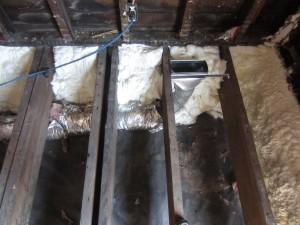I have a guest post today from my friend and fellow Louisville real estate Investor, Eric N. George. Eric's company Progress Property Solutions is a leader in the Louisville market where “greenhabbing” is concerned. Greenhabbing or “green rehabbing is not only good for the environment, but it saves the homeowner money every month at the same time.
I think you are going to love hearing about how this real estate investor has managed to set himself apart from all the other rehabbers in our area.
Greenhabbing
“Greenhabbing” or green rehabbing (eco-friendly, energy-efficient, sustainable, etc) means taking older homes and renovating them so that they, are well-insulated and air-sealed, have high-efficiency HVAC equipment, manage moisture and drainage properly, and feature some sustainable aspects, such as recycled materials used in flooring or cabinets/counter tops, etc.
If you’re an investor and in the business of rehabbing or renovating properties, you have a huge opportunity to not only increase the beauty, functionality, and character of the properties you buy, but also the health & safety, comfort, durability, and energy-efficiency as well.
Will greenhabbing a home cost you a little more up front? Yes, it can, but not always, and keep in mind that research has shown that savvy buyers are willing to pay a small premium for homes that incorporate these aspects into them.
So what’s a good example, you ask? Well, we our currently greenhabbing a shotgun-style house in Germantown, which is an older neighborhood inside Louisville, KY. The house is built on a vented crawlspace with a small cellar, has no exterior sheathing except the original wood siding, has old R11 fiberglass batt insulation in the walls, and the original wood windows are still present. Needless to say, there is plenty of room for improvement!
What we plan to do is remove the current vinyl siding and replace any damage wood siding behind with new OSB. We will then install Tyvek house wrap over the wood siding to provide a proper rain-barrier before installing the new vinyl siding. New ENERGY STAR rated low-E windows will also be installed with new flashing, and the house wrap will be properly installed and taped to the windows & doors to prevent water leaks down the road.
When we pulled down the paneling and drywall inside, we found fiberglass insulation that showed BIG signs of air movement through it over the years.
The picture shows dirt and dust that has collected in the fiberglass over the years, where air has moved through the original wood siding and into/out of the house. Remember this; fiberglass insulation does NOT stop air-movement, it filters it!
After all the insulation is removed from the house, we will use expandable foam to seal all of the gaps and cracks in the exterior siding, all electrical and plumbing penetrations into the attic, and seal around every window and door before installing new blown-in cellulose insulation.
Cellulose greatly reduces air movement in homes, and is also made largely of recycled newspaper, so it’s naturally environmentally friendly! It’s also treated with boric acid so it is also a great fire-retardant material that repels bugs and insects naturally too!
Another great example of greenhabbing on this house is what we’re doing in the crawlspace. First, we made sure the existing brick foundation walls were repaired or replaced where needed and mortar was “tuck-pointed” in between the bricks to improve the durability. We then cleaned all the junk out of the crawlspace floor and laid down 6 mil thick black plastic over the ground to act as a proper vapor barrier under the house. This is very important to reduce the relative humidity inside the home and prevent moisture damage to the wood materials in the floor structure.
After the vapor barrier was installed, we installed spray-foam insulation  onto the foundation walls and rim joists all around the house, effectively “conditioning” the crawlspace and eliminating any air-leakage from inside to out. This will help keep the floors warmer throughout the house and keep the homeowner’s utility bills lower year-round!
onto the foundation walls and rim joists all around the house, effectively “conditioning” the crawlspace and eliminating any air-leakage from inside to out. This will help keep the floors warmer throughout the house and keep the homeowner’s utility bills lower year-round!
At Progress Properties, every house we renovate we make a point to incorporate some, if not all of these aspects into them. Whether they will be long-term rental properties or short-term rehab to retail investments, it is our company policy to do things that address issues pertaining to health and safety of occupants first, and ensure our buyers or tenants will be comfortable in their new home, with low utility bills as well.
This is not only good for our clients, its good for our business too. ”Awesome” is how one tenant described the comfort in his home over the last six months. That means a lot to us, and we know it means a lot to those who are living in homes we’ve “greenhabbed”.
Be sure to stop by Eric's sites Building Performance Group and Progress Property Solutions for more information.









Hi Mike – He has some great tips. You should try to come up to our REIA meeting sometime. As always, thanks for stopping by.
Great article filled with valuable tips from Mr. George. Thanks for sharing it with us Sharon.